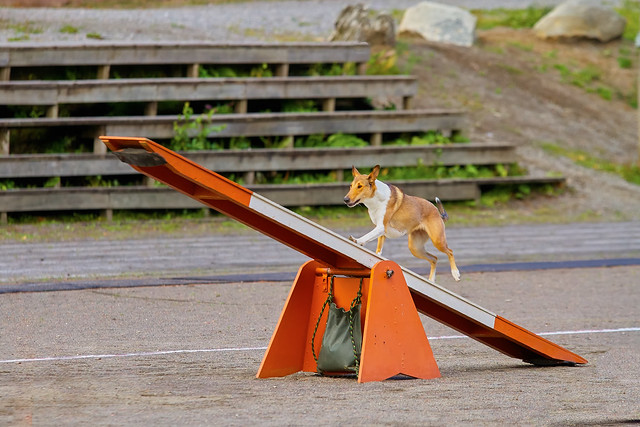 |
| Croatian Sheepdog Mawlch Gera - on agility - (Photo credit: Wikipedia) |
A timid or shy dog can only learn inside their comfort zone. So, training must begin where they feel safe and behaviors must be taught in very small increments. Home will probably be the best place to train and have learning take place for your dog.
So, how do you train at home? You will need guidelines and equipment. There is a multitude of websites that can give you information on agility training. There are also books and videos that will give details and visual aids and lesson plans for beginners thru expert levels.
There is a variety of equipment that is useful and helpful to have at home. Equipment recommendations are based on your available space and location of training. Do you have a large yard that will hold 10 obstacles? Do you have a small yard where you will need setup equipment and then tear down before you can set up again? Will you be training in your garage or basement, or as some agility addicts, in your living room.
For the timid dogs make sure your equipment is safe and sturdy. The pause table is a good place to begin your agility training. A 12” high pause table, with adjustable legs for later use, is a good starting place for all size dogs. Remember with your shy dog, set up your table in an area that is very familiar to your dog. If your dog barks at anything new, just leave your pause table in your house or yard for several days, let your dog inspect and smell it on his own or with a little coaxing, but don’t push to fast, remember baby steps with the insecure dog. With treats in a dish or his favorite toy placed on the table encourage your dog to get up on the table.
This may take more than one lesson, be patient. If your timid dog loses interest in food or toys when you attempt something new, trying holding him and you sit on the table. If your dog is too big to hold, have him on a leash and you sit on the table. If he backs away coax him, only treat or reward him when he comes to you, never when he’s pulling back away from you or the table.
Eventually, you want your dog to be able to jump on the table with your cue word, “Table”, “Box”, “Kennel”, whatever word you use, Stay on the table as you back away and then Come when you call. Build your distance slowly so that your dog is not pushed too soon.
From Pause Table to Contact Trainer is a nice transition for a shy dog. A Contact Trainer comes in different designs. We recommend a 3-Piece Contact Trainer that has one mini A-frame side, a Pause Table, and then a mini Dog-walk side.
Your dog can Sit on the table and then be coaxed down the A-frame side or the Dog-walk side. Just remember with the shy dog, training is done in increments, slowly and comfortably, with a little push to stretch him, but not enough to overwhelm him to cause a shutdown.
Your dog can Sit on the table and then be coaxed down the A-frame side or the Dog-walk side. Just remember with the shy dog, training is done in increments, slowly and comfortably, with a little push to stretch him, but not enough to overwhelm him to cause a shutdown.
You can follow the above techniques by introducing new obstacles as your dog is able to succeed. As your dog succeeds in each new piece of equipment you will see his confidence grow.





